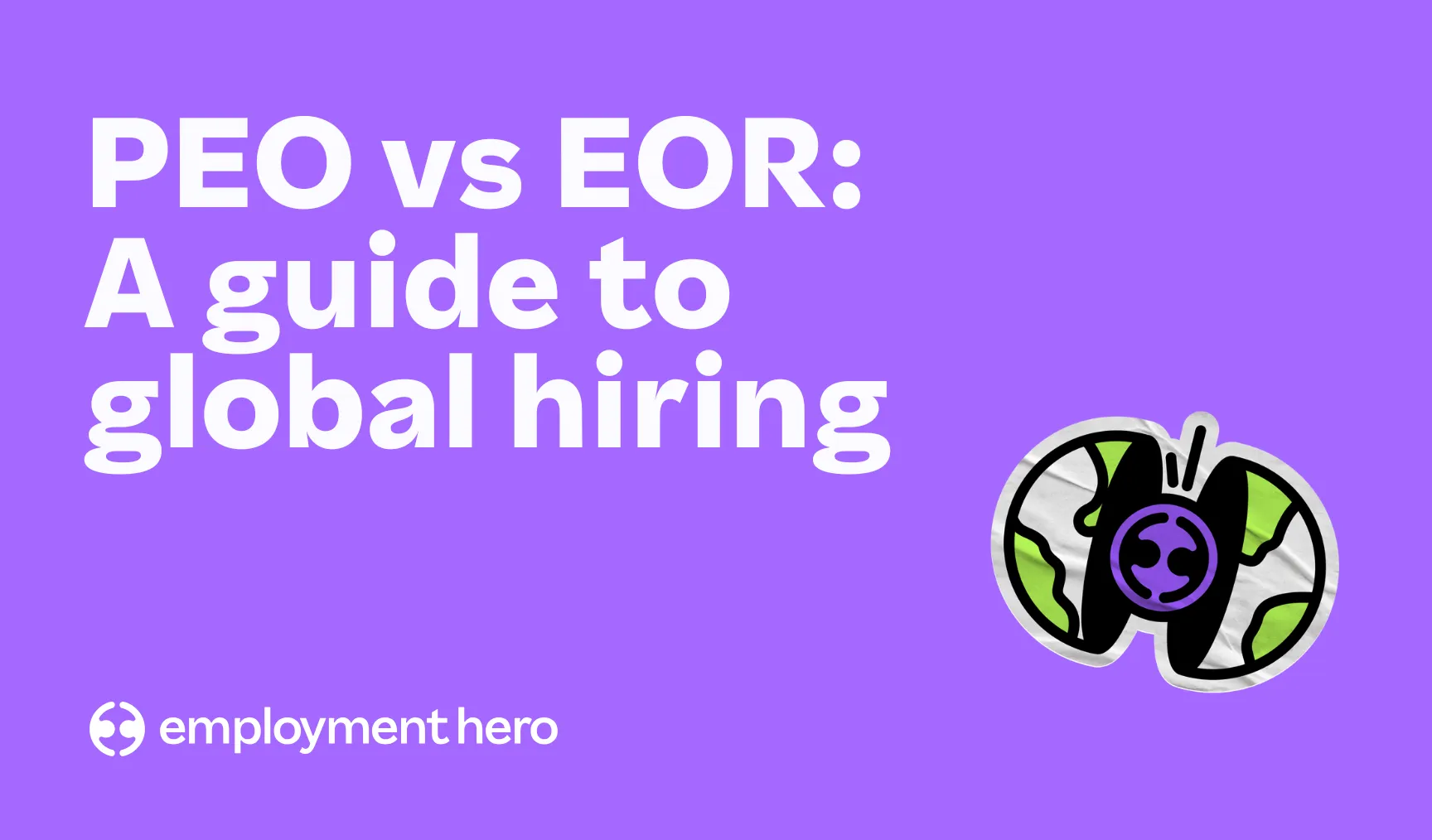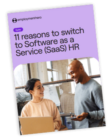AI in HR: How to keep the human in Human Resources and payroll with AI
Discover how AI can complement human efforts in HR, provide better employee experiences and enable HR teams to focus on the bigger picture.

In the ever-evolving landscape of technology, artificial intelligence (AI) continues to revolutionise various industries — human resources (HR) and payroll are no exceptions.
As organisations embrace AI to streamline processes, enhance efficiency, and drive innovation, there’s a growing concern about losing the human touch that is intrinsic to these functions. How do we strike a harmonious balance between cutting-edge technology and the empathetic, human-centered approach that defines effective HR and payroll management?
Let’s unravel the complexities of keeping the human touch with AI in HR and payroll.
Understanding the rise of AI in HR and payroll
Is AI taking the human out of human resources and payroll, or is it powering more strategic, efficient teams who end up working smarter, not harder? The adoption of AI in HR has accelerated in recent years, spurred by the need for enhanced efficiency and responsiveness to manage a rapidly evolving workforce.
Our SuperHuman: AI adoption in HR report previously revealed that AI is already being embraced by most HR leaders, with 85% of HR professionals in the UK utilising software with some form of AI. The most common application for AI tools was HR content creation (31%) presumably at the hands of generative AI (like GPT). This use of generative content creation has been at the forefront of a lot of professional conversation around streamlining templating, information finding and more with generative AI likely paving the way towards job specs, announcements and policies.
After HR content creation was identifying and reporting on employee data trends (30%), and automating tasks (based on AI models) such as reminders (27%). It seems clear that the need for efficiency, cutting through the noise and being the most productive is top of mind for HR leaders.
As the AI landscape is rapidly changing, many HR leaders also feel a sense of urgency about moving forward with AI in the HR function. According to Gartner, a massive 81% of HR leaders have explored or implemented AI solutions to improve process efficiency within their organisation. 76% of HR leaders also believe that if their organisation does not adopt and implement AI solutions, such as generative AI, in the next 12 to 24 months, they will be lagging in organisational success compared to those that do.
Utilising AI in HR for administrative efficiency
AI plays a pivotal role in automating routine administrative tasks within HR and payroll, thereby allowing teams to allocate more time for meaningful human interactions. Here are some examples of AI-driven tools:
- Applicant tracking systems (ATS): AI-powered ATS tools streamline the recruitment process by automating tasks such as resume screening and candidate matching. It can also help to identify and mitigate unconscious bias in job descriptions and interviews. These systems use machine learning algorithms to identify the most qualified candidates based on specific criteria, saving HR professionals substantial time in the initial stages of recruitment.
- Chatbots for employee queries: AI-driven chatbots are employed to handle routine employee queries, such as HR policy clarifications, leave requests, or benefits information. Chatbots use natural language processing (NLP) to understand and respond to employee inquiries, providing quick and accurate information. This frees up HR professionals from repetitive queries, allowing them to focus on more complex and personalised interactions.
- Automated payroll systems: AI is widely used in payroll processing to automate calculations, tax withholdings, and compliance checks. These systems ensure accurate and timely payroll disbursements, reducing the risk of errors associated with manual data entry. HR teams can then redirect their efforts towards more strategic tasks, such as employee development and engagement.
- Employee onboarding platforms: They streamline the onboarding process by automating paperwork, document verification, and training modules. New hires are guided through the necessary steps, ensuring a smooth and consistent onboarding experience. HR professionals can then focus on creating a welcoming environment and addressing specific employee needs.
- Time and attendance tracking systems: AI is utilised in time and attendance systems to automate the tracking of employee work hours. By integrating with biometric data or other sources, these systems provide accurate attendance records, eliminating the need for manual tracking. HR teams can then spend less time on administrative tasks related to attendance and more time on employee development initiatives.
- Employee surveys and feedback analysis: AI tools are employed to analyse employee surveys and feedback, extracting valuable insights and trends. Sentiment analysis and natural language processing allow HR professionals to understand employee sentiments better at scale, enabling targeted interventions to improve workplace satisfaction and engagement.
- Predictive hiring and scheduling: AI algorithms can consider multiple factors such as location, time of year, and more to forecast staffing needs. This leads to more accurate scheduling, preventing over- or understaffing. Having a more targeted staffing strategy not only saves costs for the business, it also provides a more balanced workload among staff, reducing employee turnover.
These are just some examples — the list keeps growing!
How can AI help to preserve the human element in HR and payroll processes?
In the realm of HR, empathy and understanding are the cornerstones of successful interactions. After all, employees are not mere cogs in a machine; they are individuals with unique experiences, challenges, and aspirations. The human touch in HR interactions goes beyond transactional processes and delves into the emotional and personal dimensions of the workplace.
Empathy in particular, the ability to understand and share the feelings of another, plays a pivotal role in fostering a positive work environment. When equipped with empathy, HR professionals can connect with employees on a deeper and more personal level, addressing concerns, offering support, and building trust. This connection is crucial for employee engagement, satisfaction, and overall well-being.
However, the increasing complexity of HR tasks, driven by the digital age and organisational growth, poses challenges to maintaining this empathetic connection. This is where AI steps in as a powerful ally, complementing human efforts rather than replacing them. AI can handle routine and time-consuming tasks such as data processing, payroll calculations, and administrative functions, freeing up HR professionals to focus on the strategic and empathetic aspects of their roles.
By automating repetitive tasks, AI allows HR professionals to invest more time in understanding the unique needs of employees, providing personalised support, and crafting better strategies that nurture a positive workplace culture. This shift in focus empowers HR teams to become strategic partners within organisations, contributing to talent development, employee engagement, and overall organisational success.
Moreover, AI can enhance the decision-making process by providing data-driven insights, allowing HR teams to make informed choices that align with both organisational goals and employee well-being. This synergy between human intuition and AI-driven analytics creates a powerful combination.
In essence, the integration of AI in HR does not diminish the importance of human empathy and understanding; rather, it enhances these qualities by removing the burden of routine tasks. By enabling HR professionals to channel their emotional intelligence towards more meaningful interactions, creating a workplace where employees feel heard, valued, and supported, everyone gets to benefit!
Training and upskilling: empowering the human element
The increase in AI use across our workplaces has made us reconsider our role within them. Many HR leaders look to prioritise soft skills, perhaps with the intention of enhancing communication, teamwork, customer service and adaptability amongst others.
More AI tools = a greater need for data-savviness
According to 36% of respondents in our survey, the top skill their teams would need to be AI-ready was data analysis or HR analytics (36%). This might showcase how a lot of professionals sense a skills gap around their capability to analyse data or perhaps strategise using larger quantities of data. It’s perhaps unsurprising to see data analysis and analytics score so highly here as the big data trend continues to solidify its place in UK businesses. And with more and more tools helping HR and payroll professionals understand and interpret data, the more important it is for them to be aware of how these tools work.
Soft skills are also sought after
Apart from data analysis skills, HR leaders in the UK saw soft skills (31%) and ethics and responsible use of AI (26%) amongst the most important skills to develop. We know that soft skills contribute to a positive work environment, improved customer satisfaction, and overall organisational success. And perhaps as AI increases in its capability, HR leaders are more aware we’ll need to be ready to manage risk and make difficult decisions based on AI learning and data.
Upskilling HR and payroll teams a necessity
As AI continues to reshape the functions of HR and payroll, ensuring that teams possess the necessary skills to work effectively alongside these technologies becomes imperative. By upskilling, professionals can embrace the collaborative potential of AI, ensuring that the technology boosts their capabilities, rather than replacing them. This approach not only future-proofs HR and payroll roles, but also enhances the overall employee experience by combining the efficiency of AI with the human touch of skilled professionals.
Moreover, upskilling HR and payroll teams leads to these benefits:
- Efficient integration of AI technologies: Upskilling enables HR and payroll professionals to understand and integrate AI technologies seamlessly into their workflows. This ensures that AI tools are not only implemented effectively but also used to their full capacity, optimising processes and improving overall efficiency.
- Improved problem-solving abilities: AI may automate routine tasks, but complex issues often require human intuition and critical thinking. Upskilling equips HR and payroll teams with advanced problem-solving skills, enabling them to address unique challenges, handle employee concerns, and navigate complex ethical considerations associated with AI applications.
- Adaptability to changing technologies: The technology landscape is dynamic, and new AI applications are continually emerging. Upskilling ensures that HR and payroll professionals remain adaptable and can quickly incorporate new technologies into their processes, staying ahead of industry trends and maintaining a competitive edge.
- Enhanced employee interactions: With AI handling repetitive tasks, HR and payroll professionals can focus more on human-centric aspects of their roles. Upskilling in communication and interpersonal skills enables these professionals to foster stronger relationships with employees, providing empathetic support, and creating a more positive workplace culture.
- Employee trust and confidence: When HR and payroll teams are proficient in working with AI, employees are more likely to trust the technology and the decisions made by it. Upskilling ensures that professionals can communicate effectively about AI applications, alleviating concerns and building confidence in the workforce.
Foster a human-centric approach in your business today
While AI can automate certain tasks and processes, it is crucial to maintain a human-centric approach to HR. Recognise the unique value that human skills bring, such as empathy, creativity, relationship-building and complex problem-solving. Strive for a balance between AI and human capabilities, leveraging AI to streamline and support HR practices while keeping the focus on the personal aspects of employee management.
By leveraging an all-in-one, cloud-based HR and payroll software like Employment Hero, you’ll be able to focus on what’s truly essential — your employees. Plus, the platform is continuously improved upon with AI enhancements and new features, so you can leave all the tech work to us while you reap the benefits.
If you’re an accountant, bookkeeper, business services firm, consultant or serve SMEs in industries like financial services, utilities or telecommunications, get in touch with us. You’ll get rewarded when you refer your clients through to us — all while growing your business and strengthening your client relationships. It’s a win-win.
Related Resources
-
 Read more: Setting employee expectations: Your guide to getting it right
Read more: Setting employee expectations: Your guide to getting it rightSetting employee expectations: Your guide to getting it right
Learn how to set clear employee expectations to boost productivity and engagement. Discover actionable tips and strategies for leadership success.
-
 Read more: PEO vs. EOR: A guide to global hiring
Read more: PEO vs. EOR: A guide to global hiringPEO vs. EOR: A guide to global hiring
Contents Expanding your business into new markets is a powerful growth strategy. But hiring talent globally introduces a maze of…
-
 Read more: How to build a global team without a local entity
Read more: How to build a global team without a local entityHow to build a global team without a local entity
Learn how to streamline your hiring and expand your UK business globally with an Employer of Record (EOR) without the…





















